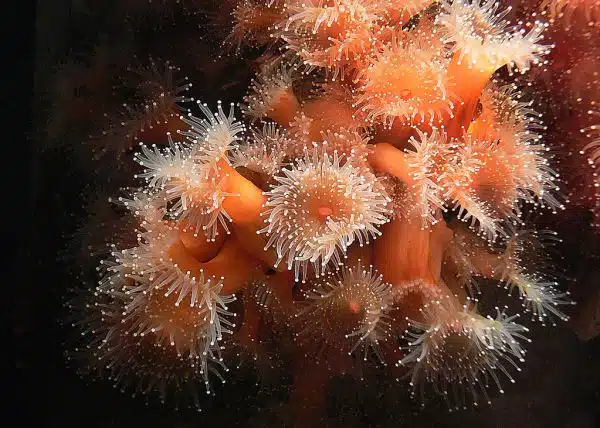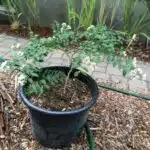Anemone ‘Honorine Jobert’ is a popular flowering plant that adds a touch of elegance to any garden. Known for its pure white, single flowers and dark green foliage, this anemone variety is easy to grow and care for. However, to get the best results, it is important to understand the ideal growing conditions, planting techniques and maintenance requirements.
As a horticultural expert, I have had extensive experience with growing Anemone ‘Honorine Jobert’. In this article, I will share my knowledge on how to successfully cultivate this plant in your own garden. Whether you are a seasoned gardener or just starting out, following these tips will help you achieve beautiful blooms that will serve as a source of joy and inspiration for yourself and others.
Understanding Anemone ‘Honorine Jobert’
Anemone ‘Honorine Jobert’ is a beautiful, herbaceous perennial plant that belongs to the Ranunculaceae family. It produces large, pure white flowers with yellow centers that bloom in late summer and early fall, making it an excellent choice for adding color to any garden. This plant can grow up to 3-4 feet tall and prefers rich, well-draining soil.
Characteristics of Anemone ‘Honorine Jobert’ include its hardiness in USDA zones 4-8 and its ability to thrive in partial shade or full sun. This variety is also resistant to deer and rabbits, making it a great option for gardens located in areas with high wildlife populations. Additionally, this plant can be easily propagated through division in the spring or fall.
There are several varieties of Anemone available on the market, but ‘Honorine Jobert’ stands out due to its striking white blooms and ease of care. When choosing this variety for your garden, it is important to consider the size of your planting area as this plant can spread quickly if left unchecked. In the next section, we will discuss how to choose the right location for planting Anemone ‘Honorine Jobert’.
Choosing The Right Location
A crucial factor in the successful growth of anemone ‘Honorine Jobert’ is choosing the right location. This plant requires a spot that receives partial shade and plenty of sunlight. The ideal location for this plant would be under trees or near shrubs that provide a bit of shade during the hottest times of the day.
The soil composition is another essential aspect to consider when planting anemone ‘Honorine Jobert.’ This plant thrives in well-draining soil that is rich in organic matter. It is best to avoid planting this particular species in clay soils as they retain too much water, which can cause root rot and other problems.
Sun exposure and soil composition are factors that play a significant role in the growth and development of anemone ‘Honorine Jobert.’ Once you have identified the perfect spot for your plant, it’s time to prepare the soil carefully. In the subsequent section, we will discuss how to prepare your garden bed for optimal results when growing this beautiful plant.
Preparing The Soil
Soil preparation is crucial in growing healthy and vigorous anemone ‘Honorine Jobert’ plants. The ideal soil type for this plant is a well-draining loamy soil with a pH level of 6.0 to 7.5. Before planting, it is important to prepare the soil by removing any weeds or debris that may hinder the growth of the plant.
One way to improve soil quality is by adding organic matter such as compost, aged manure, or leaf mold. This will not only provide essential nutrients but also improve soil structure and water retention capacity. Another option is to use slow-release fertilizers that are high in phosphorus and potassium, which are essential nutrients for root development and flower production.
It is important to note that anemone ‘Honorine Jobert’ requires consistent moisture throughout the growing season. Therefore, it is recommended to water deeply once or twice a week rather than frequent shallow watering. Adding mulch around the base of the plant can help retain moisture and prevent weed growth.
Preparing the soil for anemone ‘Honorine Jobert’ is a critical step in ensuring its health and productivity. By providing adequate nutrient requirements through organic matter or slow-release fertilizers, gardeners can create an optimal growing environment for this stunning perennial plant. In the next section, we will discuss how to properly plant anemone ‘Honorine Jobert’.
Planting Anemone ‘Honorine Jobert’
After preparing the soil for your anemone ‘Honorine Jobert’, it is time to move on to the next step of planting. This particular variety of anemone is known for its early bloom and large, white flowers. To ensure optimal growth, it is important to choose the right location for planting. Anemones thrive in partial shade, so look for a spot that receives morning sun but is shaded in the afternoon.
When planting ‘Honorine Jobert’, consider companion planting. This technique involves planting different species together that will benefit each other’s growth. For example, plant your anemones alongside ferns or hostas as they prefer similar growing conditions and will complement each other’s aesthetic appeal. Avoid planting them near trees or shrubs as they may compete for nutrients and water.
To care for your newly planted anemone ‘Honorine Jobert’, watering and fertilizing are crucial aspects of maintenance. Keep the soil moist but not waterlogged as this can lead to root rot. Watering deeply once a week during dry periods should suffice, but monitor the soil consistently to ensure it does not become too dry between watering sessions. Fertilize annually in the spring with a slow-release fertilizer specifically formulated for flowering perennials.
Now that you have successfully planted your anemone ‘Honorine Jobert’ with a companion plant and understand how to properly care for it through watering and fertilizing techniques, you can sit back and watch as it blooms beautifully in your garden. Remember to continue monitoring its growth throughout the season and make adjustments if necessary to ensure optimal health and vitality.
Watering And Fertilizing
As the saying goes, “water is life.” Watering frequency is a critical aspect of growing anemone ‘Honorine Jobert.’ This plant requires moist soil but not waterlogged. Overwatering can lead to root rot, which can be fatal to the plant. On the other hand, underwatering causes wilting, which can also harm the plant. Therefore, it is crucial to find a balance in watering.
Fertilizing is essential in promoting healthy growth and robust blooms in anemone ‘Honorine Jobert.’ Applying fertilizer types that are high in phosphorus encourages blooming while those high in nitrogen promote vegetative growth. A balanced fertilizer with equal proportions of nitrogen, phosphorus, and potassium (NPK) is ideal for this plant. Apply fertilizer once every two weeks during its active growing season.
To help you understand the proper watering frequency and fertilizer types for your anemone ‘Honorine Jobert,’ we have provided a table below:
| Plant Needs | Watering Frequency | Fertilizer Type |
|---|---|---|
| Moist soil | Once per week | Balanced NPK |
| Blooming | As needed | High Phosphorus |
| Vegetative growth | As needed | High Nitrogen |
Now that you know how often to water and what type of fertilizer to use for your anemone ‘Honorine Jobert,’ let’s move on to pruning and deadheading.
Pruning And Deadheading
Pruning and deadheading are important horticultural practices for growing anemone ‘honorine jobert’. Fertilizing with a balanced fertilizer, watering regularly, and providing adequate sunlight are essential for healthy growth and strong blooms. Soil preparation should involve the addition of organic matter, and planting depth should be no more than three inches. Planting location should be in a partially shaded area, plant spacing should be 12 inches apart, and plant division should be done in the spring. Winter care should involve mulching, re-potting, disease prevention, and pest control to ensure the health and survival of the anemone ‘honorine jobert’.
Pruning
Pruning is an essential technique in maintaining the health and appearance of anemone ‘Honorine Jobert’. Proper pruning techniques allow for the removal of damaged, diseased or dead plant parts, improving overall plant health. However, pruning must be done with care as it can directly affect the flowering performance of the plant.
Timing considerations are crucial when it comes to pruning anemone ‘Honorine Jobert’. The best time to prune is during late winter or early spring before new growth emerges. This timing allows for the removal of old stems and leaves, promoting new growth and increasing flower production. It is important to avoid heavy pruning during the growing season as this can reduce flower production and weaken plant vigor.
When pruning anemone ‘Honorine Jobert’, it is recommended to use clean, sharp tools to minimize damage to the plant. Start by removing any dead or damaged stems at ground level, making sure not to cut into healthy tissue. Then, thin out congested areas by cutting back some stems at their base while leaving others untouched. This promotes air circulation and sunlight penetration which reduces disease incidence and encourages more vigorous growth. By following these simple guidelines on pruning techniques and timing considerations, gardeners can maintain a healthy and attractive anemone ‘Honorine Jobert’ that will bloom profusely year after year.
Deadheading
Pruning is an essential technique in maintaining the health and appearance of anemone ‘Honorine Jobert’. However, it is not just about removing damaged or diseased plant parts. Deadheading, or the removal of spent flowers, is also crucial in improving the overall performance of the plant. Deadheading can provide numerous benefits such as encouraging more blooms, extending the flowering period, and preventing seed production that can be detrimental to plant vigor.
The frequency of deadheading depends on the growth rate of anemone ‘Honorine Jobert’. Generally, it is recommended to deadhead every week or two during the growing season. This ensures that spent flowers are removed promptly before they start producing seeds. As a result, the plant puts its energy into producing new buds instead of wasting resources on seed production.
Deadheading anemone ‘Honorine Jobert’ is a simple process that involves cutting off old blooms with clean and sharp tools. It is important to make sure not to cut into healthy tissue while doing so. By incorporating this practice together with proper pruning techniques, gardeners can maintain a healthy and attractive anemone ‘Honorine Jobert’ that will bloom profusely for months on end.
Fertilizing
In addition to pruning and deadheading, fertilizing is another crucial aspect of maintaining a healthy anemone ‘Honorine Jobert’. Fertilizers provide essential nutrients that the plant needs to grow and thrive. There are two main types of fertilizers that gardeners can use: organic and chemical.
Organic fertilizers are derived from natural sources such as compost, manure, or bone meal. These fertilizers slowly release nutrients into the soil over time, providing a steady supply of food for the plant. They also improve soil structure and fertility, promoting healthy root growth. On the other hand, chemical fertilizers are manufactured products that contain specific ratios of nitrogen, phosphorus, and potassium. These fertilizers provide quick-release nutrients but can also lead to over-fertilization if not used properly.
When it comes to fertilizing anemone ‘Honorine Jobert’, it is important to choose a fertilizer that is appropriate for the plant’s needs. A balanced fertilizer with equal amounts of nitrogen, phosphorus, and potassium is ideal for promoting overall growth and health. Gardeners should also follow manufacturer instructions carefully when applying fertilizers to prevent over-fertilization or burning of the plant roots. With proper fertilization in conjunction with pruning and deadheading techniques, gardeners can maintain a vibrant and healthy anemone ‘Honorine Jobert’ that will continue to bloom beautifully season after season.
Dealing With Pests And Diseases
Like any other plant, anemone ‘honorine jobert’ is prone to pests and diseases. Some of the common pests that can attack these plants are aphids, spider mites, and thrips. Aphids suck sap from the leaves and stems, causing them to wilt and yellow. Spider mites cause yellow spots on the leaves, which eventually turn into brown patches. Thrips damage the flowers by sucking their juices, causing them to shrivel up and die.
There are several natural remedies that you can use to control these pests without resorting to chemical treatments. One effective method is to spray your plants with a mixture of water and dish soap. This will suffocate the insects by clogging their respiratory system. Another natural remedy is to use neem oil, which is derived from the neem tree. Neem oil contains azadirachtin, a compound that repels insects and prevents them from feeding on your plants.
If natural remedies do not work, you may need to resort to chemical treatments. However, it is important to follow the manufacturer’s instructions carefully when using pesticides or insecticides. Always wear protective clothing when handling these chemicals and keep them out of reach of children and pets.
In conclusion, anemone ‘honorine jobert’ can be vulnerable to various pests and diseases that can affect its health and growth. As a gardener or horticulturalist, it is important to take proactive measures in preventing pest infestations by using natural remedies before having to resort to chemical treatments if necessary. The next section will provide tips on how best to overwinter anemone ‘honorine jobert.’
Overwintering Anemone ‘Honorine Jobert’
Anemone ‘Honorine Jobert’ is a stunning perennial with pure white flowers that bloom in late summer and early fall. This plant is known for its elegance and grace, qualities that are often associated with the white color. Like a blank canvas, the white petals of ‘Honorine Jobert’ can symbolize endless possibilities and new beginnings.
To ensure this beauty thrives year after year, it’s important to protect its roots during the winter months. This plant has moderate frost tolerance, but its roots are susceptible to freezing. To prevent this from happening, provide a protective layer of mulch around the base of the plant once the ground freezes. This will help maintain consistent soil temperatures and keep the roots insulated.
In addition to protecting roots, there are other steps you can take to overwinter Anemone ‘Honorine Jobert’. Here are three tips:
- Cut back stems after flowering has ended to prevent wind damage.
- Avoid excessive watering in late summer and early fall to encourage proper hardening off before winter.
- Consider planting in a location with some afternoon shade to protect against sunscald on cold days.
As we have seen, protecting roots and ensuring proper care in late summer/early fall are key factors for successfully overwintering Anemone ‘Honorine Jobert’. In our next section, we will explore propagation techniques for this beautiful plant.
Propagation Techniques
Propagation Techniques:
One of the propagation benefits of growing anemone ‘Honorine Jobert’ is that it can be propagated through division. This method involves digging up the plant, separating the clumps or offsets, and replanting them in well-draining soil. This should be done during early spring or fall when the plant is dormant. Division not only increases your stock of plants but also rejuvenates older ones.
Another propagation technique for anemone ‘Honorine Jobert’ is through stem cuttings. Take 4-6 inch cuttings from healthy plants in spring or summer and dip them in rooting hormone before planting them in a pot with moist soil mix. Place the pot in a warm, bright location but out of direct sunlight. Keep the soil moist and wait for roots to develop before transplanting to their permanent location.
Common mistakes when propagating anemone ‘Honorine Jobert’ include overwatering, which can result in root rot, and not providing enough light, which can cause leggy growth. It is also important to ensure that you are propagating from healthy plants to avoid introducing diseases into your garden. With proper care and attention, however, propagating anemone ‘Honorine Jobert’ can be a rewarding experience that allows you to enjoy more of these beautiful flowers in your garden.
With these propagation techniques at hand, you can now increase your collection of anemone ‘Honorine Jobert’. Once you have propagated these lovely flowers successfully, it’s time to sit back and enjoy their beauty. In the next section, we will explore how to care for your anemones so that they thrive and provide stunning displays year after year.
Enjoying The Beauty Of Your Anemone ‘Honorine Jobert
After successfully propagating your Anemone ‘Honorine Jobert’, the next step is to ensure its proper growth and care. With proper attention and care, this beautiful perennial plant can bloom for years to come, adding a touch of elegance to your garden.
Seasonal care is crucial in the growth of Anemone ‘Honorine Jobert’. In spring, it is essential to fertilize the soil with compost or well-decomposed manure to enrich the soil’s nutrient content. During summer, regular watering is necessary, especially during extended periods of dry weather. Autumn brings a change in temperature and shorter days, signaling the plants to prepare for dormancy. At this point, it is vital to cut back old foliage and stems, allowing new ones to grow in preparation for winter.
Companion planting can also help improve the growth of Anemone ‘Honorine Jobert’. Planting it alongside other perennials such as hostas and ferns can provide shade during hot summer months while also creating an aesthetically pleasing garden design. Additionally, planting them alongside tall grasses can offer support against strong winds.
- Keep soil consistently moist but not waterlogged
- Deadhead spent blooms regularly to encourage new growth
- Mulch around plants to help retain moisture and suppress weed growth
- Provide adequate sunlight exposure (4-6 hours per day)
With proper seasonal care and companion planting techniques, your Anemone ‘Honorine Jobert’ will thrive beautifully in your garden. As you enjoy its stunning white flowers dancing in the gentle breeze, remember that your efforts are rewarded by nature’s beauty.
Conclusion
Anemone ‘Honorine Jobert’ is a beautiful and easy-to-grow perennial that can add a touch of elegance to any garden. By following the right steps, you can successfully grow this stunning plant and enjoy its blooms for years to come.
Start by choosing a location that provides partial shade and well-drained soil. Prepare the soil by adding organic matter and ensure proper watering and fertilization. Keep an eye out for pests and diseases, but don’t fret – these issues are easily manageable with proper care.
Overwintering your Anemone ‘Honorine Jobert’ is essential for its survival, so make sure to mulch it properly in colder months. Finally, propagate your plant through division or cuttings to share its beauty with others.
In conclusion, growing Anemone ‘Honorine Jobert’ is a rewarding experience that can enhance any garden’s aesthetic appeal. As horticultural experts, we encourage you to take on this challenge and watch as your plant flourishes over time. Ask yourself: what other stunning plants could you add to your garden?
Image Credits
- “Sea anemones. Monterey Aquarium.” by Bernard Spragg (featured)





























